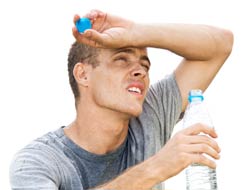  Sizzling Summer Precautions Sizzling Summer PrecautionsFor visitors and workers alike, summertime turns parks and preserves into a buzzing hive of activity, but amid the activity, don’t forget to take some extra precautions to avoid summers’ heat-related illnesses.
“When your body temperature control system is overloaded, you can become the victim of a heat-related illness,” notes Jackie Pierce, PDRMA Risk Management Consultant. “Heat affects different people in different ways with different symptoms, ranging from sunburn to serious or even life-threatening conditions.”
Those most at risk: According to the Centers for Disease Control, those over 65 or under age 4 are most at risk. “PDRMA members who work or program with people in these age groups need to stay alert," Pierce adds. “Remember, too, that the activity level and heat index are huge factors in heat-related illnesses.”
  Work intensity and duration: The National Weather Service issues Heat Advisories when summer heat becomes extreme, but smart risk management means developing good hot-weather procedures and habits long before a heat wave hits. Working in high heat, humidity or direct sun — and working without proper hydration — can be big problems. After a half hour working in the sun, encourage staff to move to another task in the shade, rehydrate with water and avoid drinks with caffeine. Remind outdoor workers to use sunscreen, as well, and to reapply often to protect their skin. Work intensity and duration: The National Weather Service issues Heat Advisories when summer heat becomes extreme, but smart risk management means developing good hot-weather procedures and habits long before a heat wave hits. Working in high heat, humidity or direct sun — and working without proper hydration — can be big problems. After a half hour working in the sun, encourage staff to move to another task in the shade, rehydrate with water and avoid drinks with caffeine. Remind outdoor workers to use sunscreen, as well, and to reapply often to protect their skin.
  Stay hydrated — the right way: Water or electrolyte drinks — not alcohol or caffeine drinks such as iced tea, coffee or soda — are the best way to prevent dehydration. In warm or hot conditions, drinking enough water (one quart per hour during the entire work shift) is vital for maintaining a normal body temperature and hydration. Provide coolers for employees so they have access to water wherever they may be working (i.e., buildings, vehicles and equipment). Stay hydrated — the right way: Water or electrolyte drinks — not alcohol or caffeine drinks such as iced tea, coffee or soda — are the best way to prevent dehydration. In warm or hot conditions, drinking enough water (one quart per hour during the entire work shift) is vital for maintaining a normal body temperature and hydration. Provide coolers for employees so they have access to water wherever they may be working (i.e., buildings, vehicles and equipment).
Beware of all heat-related factors: Excessive heat results from more than just temperature and humidity. Heat illness can be triggered by a complex calculation that considers air temperature, humidity, time spent in direct sunlight, radiant heat and lack of air movement, as well as work or sport activities. Just because you’re in the shade doesn’t mean you’re protected from heat-related illnesses. Be mindful of heat index reports that incorporate all heat related factors.
Know the signs: Common symptoms of moderate to severe dehydration include reduced sweating, muscle fatigue, loss of strength and dexterity, dizziness and headache. More serious symptoms include nausea, cramps, hallucinations, shallow breathing and excessive sweating. If you notice these signs in yourself or others, try to cool down the person and seek medical advice immediately.
PDRMA Resources:
|

